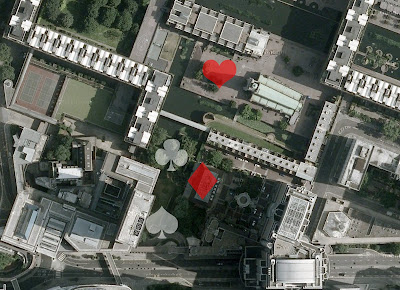The past few days I have been looking into the history of 'Playing Cards' and how they might relate to socially within the site today and in Elizabethan times. Below is a brief timeline on how the cards came into England and where they originated from.
It is believed that initially playings cards where brought over to the Britain by the English soldiers in battles in France. The first recorded mention of playing cards was in the 14th Century, however none have survived from such an early date. As card playing became popular it was a Christmas Festivity as monarchs such as Henry VII forbade servants to use the expect for at Christmas time. Soon after an Act of Parliament was released which prohibited the import of playing cards. In the Early 15th Century gambling became so popular it provoked a reaction from the church so Monk Bernadine of Sienna preached to the public and a large population of the church religion burnt their cards.
In the 17th Century playing cards mainly became an immoral activity with gambling becoming a recurring problem. However thousands of cards were destroyed in 1664-1666 during The Plague and The Great Fire of London. When Charles II was restored as King he brought an order and continuity to card game playing and this is where we have surviving packs of cards start emerging. The Worshipful Company of Makers of Playing cards was introduced in 1628 by Charles II where a tax was taken from each pack of cards and paid to the King. The tax stamp was to be placed on the Ace of Spades of every card, if you look at a pack of cards this is the card which is most decorated to represent the tax mark. You can also see this on playing cards today.
Later number were added as well as symbols to make the cards more ergonomic so people could fan the cards out. Most cards were plain on one side but the Victorians added detail to avoid cheating. The Joker or Fool card wasn't introduced until mid 19th Century by workers in Mississippi America where they added the card to create a double trump it was known as 'The Jolly Joker' it eventually reached the English packs in 1880. Dianne Longley said 'The Joker is the wild-card or the card of opportunity or individuality...' www.wopc.co.uk
While looking into the history of the cards I noticed there are similar familiarities with the Christian Calendar, for example...
Deck contains 52 cards - There are 52 weeks in the year
4 Suits - 4 Season
12 Picture cards - 12 Months
13 Different denominations - 13 the number of lunar cycles a year.
Also when the suits were accepted by all card playing nations they represented 4 classes of medieval society -
Heart symbolised the Church
Pikes (Spade) represented the Military
Paving Tile (Diamond) was a symbol of the Merchant Class
Clover Leaf for Farmers
I think that the representation of each symbol works well on the site there is quite a direct link to all of the meanings. I am going to look further into this research and how it can help me develop the theory and context not he site.

No comments:
Post a Comment